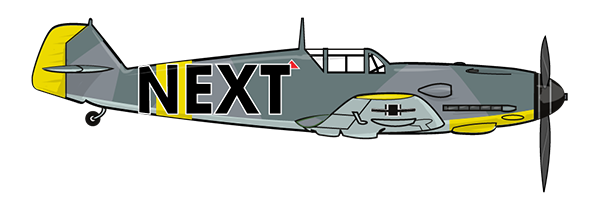A Field Guide to WWII Aircraft Camouflage,
or how ten million model builders can make a simple paint job really complicated
 |
 |
 |
 |
 |
 |
 |
|---|---|---|---|---|---|---|
| Japanese | German | Italian | French | British | Soviet | American |
One of the first rules of aerial dogfighting, and one that still applies today, it that what you don't see CAN hurt you. In fact, what you don't see can put several twenty millimeter cannon shells into the small of your back in just a fraction of a second, so it pays to stay alert. Good eyesight has always been an important job requirement for fighter pilots, and spotting and quickly identifying enemy aircraft an important skill that ultimately resulted in those nifty little airplane spotter playing cards you can buy at any local airshow. The owners and operators of the air forces of the world know this and, having gone to the tremendous expense of buying all those shiny airplanes, they have developed a wide variety of ways to hide them from the eyes of those who would shoot them down.
The camouflage and marking of aircraft has not only saved countless lives, it has spawned a whole postwar industry of decal sheets, modelbuilding guides, historical lacquer paints and at least one book company. It has also developed into a matter of some debate, as most wartime pilots never really cared much what color their plane was during wartime, provided it did its job and didn't have a bullseye painted on it. So no one really bothered to keep very good records of just what color their plane was, and now have little to offer the historians of today other than a few sun-faded photos and an occasional colorful anecdote.
All to the chagrin of that most militant of airplane spotters, the modelbuilder, whose obsession with color matching borders on the psychotic. You see, like most things that people argue incessantly about, color is a very relative thing. We all perceive color somewhat differently, and its fugitive hues are only further obscured by its tendency to change over time. Color is the most visible example of Heisenburg's Uncertaintly Principle you will encounter in daily living, and its true nature is subject to the whimsy of ambient light, chemical composition, temperature, the cellular makeup of your eyes, and sometimes even that flickering piece of electronic voodoo called a monitor.
So who the heck really knows what color anything is?
Well, modelbuilders know, or think they know, or think they can find out if they argue about it long enough, or travel to the steamy jungles of some forgotten Pacific Isle to scrape the leavings from the bottom of the rusty ruin of a wrecked Zero. And, indeed, modelbuilders are one of the best sources of information regarding the color and markings of WWII aircraft.
I know. I've seen their web pages. I plowed through hundreds of them in my own search for similar information. As an illustrator who likes to paint pictures of airplanes, I find myself having to know the same things that modelbuilders want to know. Unfortunately, they have made my searches excruciatingly painful at times, with cryptic references to expensive, out-of-print books and obscure color matching systems. It has all proven maddening at times, so I finally decided to write it all down, in order to spare other armchair historians the same headaches.
The goal of this guide is to be informative and easy to use, and does not bog the curious knowledge seeker down with too many pesky and often irrelevant details: it is the book that I had wished I could have found when I was first delving into the seemingly bottomless topic of aircraft camouflage and markings. It does not attempt to be an exhaustive list of all known markings and camouflage schema ever used...simply a useful primer that indicates the most common uses of color and markings, and their meaning.
I hope you find it helpful. Should you find any glaring innacuracies, or feel you have some information that might make it even more helpful, feel free to tell someone in a modelbuilding club. They will be happy to argue with you.
 |
 |
 |
 |
 |
 |
 |
|---|---|---|---|---|---|---|
| Japanese | German | Italian | French | British | Soviet | American |







